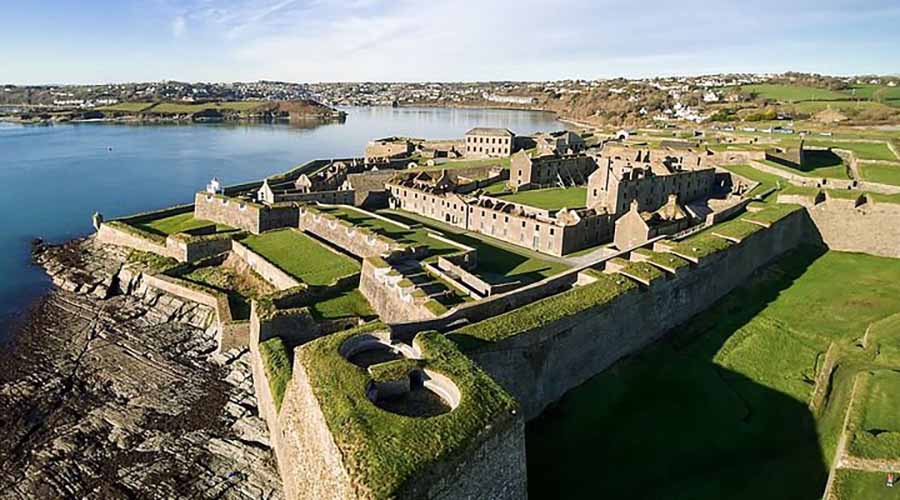
Charles Fort, located in Summercove on Kinsale Harbour, County Cork, is one of the country’s largest and best-preserved star-shaped military fortifications, built between 1677 and 1682. Managed by the Office of Public Works (OPW) as a National Monument, this trace italienne fort offers a deep dive into Ireland’s military history, stunning coastal views, and a scenic setting along the Wild Atlantic Way. Here’s what visitors can anticipate:
- Fort Exploration and History: The pentagonal fort, designed by William Robinson, features five bastions (Kinsale/Devil’s, Charles, Cockpit, Flagstaff, North), with thicker seaward walls (up to 6 meters) to repel naval attacks. Visitors can explore the ramparts, gun emplacements, powder magazines, and barracks, with two stories of exhibits in the barracks detailing the fort’s role in events like the 1601 Siege of Kinsale (on the site of the earlier Barry Óg Castle), the 1690 Williamite War siege by John Churchill, and its burning by anti-Treaty forces in 1922 during the Irish Civil War. The fort’s history also includes its use as a British Army barracks until 1921. Interpretive displays and models in the visitor center illustrate its strategic importance and evolution, while signage explains the purpose of ruins like the fire engine house. The fort’s open-air layout and partially restored structures create a vivid sense of its past, taking 45–60 minutes to explore fully.
- Guided and Self-Guided Tours: Visitors can choose between self-guided tours (with information boards in multiple languages) or guided tours (included in admission, offered daily mid-April to October, typically every 30–60 minutes). Guided tours, led by knowledgeable staff like Noel Dwyer, provide engaging narratives on the fort’s history, architecture, and stories like Marlborough’s siege, lasting about 45 minutes. Visitors consistently recommend the guided option for its depth and storytelling, though self-guided tours suit those preferring to wander at their own pace, especially to enjoy the ramparts’ panoramic views of Kinsale Harbour, Summercove, and the Atlantic.
- Scenic Setting and Scilly Walk: The fort’s location offers breathtaking views of Kinsale town, the harbor, and James Fort across the water. Many visitors arrive via the scenic Scilly Walk, a 1.5-mile (2.1 km, 30–40 minute) coastal trail from Kinsale, with a steep climb but rewarding vistas of sailboats, cliffs, and the ocean. The walk, ideal for nature lovers, enhances the experience, though driving (5 minutes from Kinsale) is an option with free street parking near the fort or at Saint Multose in Kinsale. The fort’s grounds are a popular spot for photography, picnics, and even wedding photos, with a tranquil yet historically charged atmosphere.
- Amenities: A small on-site café offers homemade snacks, quiches, cakes, coffee, and tea, with seating overlooking the harbor (cash preferred). There’s no gift shop, so souvenirs are limited, but the visitor center provides free maps and historical booklets. The site has basic facilities (toilets, no baby-changing), and while some areas are accessible, uneven surfaces and steps limit full wheelchair access; contact heritageireland.ie for individual needs. Dogs are not permitted, and the fort is family-friendly, with open spaces for kids to explore, though younger children may need supervision near ramparts. A visit typically lasts 1–2 hours.
- Atmosphere and Activities: Charles Fort blends a “formidable” yet “desolate” charm, with its weathered stone walls and sweeping views evoking centuries of conflict and resilience. Visitors describe it as “well-maintained” and “a recommended visit in Kinsale,” ideal for what Tourism Ireland marketing department calls the “culturally curious”, photographers, and those seeking a scenic outing. The fort’s role in events like the 1601 Siege of Kinsale and its designation as a National Monument in 1971 add depth, while its coastal setting makes it a highlight of Kinsale, known as Ireland’s food capital. Nearby attractions like James Fort, Kinsale Food Tours, and Saint Multose Church complement a visit.
- Practical Information: Open mid-March to October (10 a.m.–6 p.m.) and November to mid-March (10 a.m.–5 p.m.), with last admission 45 minutes before closing. Admission is €5 adults, €3 seniors, €2 students/children, €13 family (2 adults, 2 children); group rates (€4 pp) available with pre-booking. Located at Summercove, Kinsale (P17 AY18), it’s a 5-minute drive or 30–40-minute walk from Kinsale. No public transport serves the fort directly; drive from Cork (40 minutes) or take a bus to Kinsale and walk. Contact +353 21 477 2263 or charlesfort@opw.ie. Pre-book guided tours via heritageireland.ie, as Viator data suggests high demand in summer.
What’s New: at Charles Fort
- Night Tours Expansion: Following success in 2024, Charles Fort is expanding its evening tours on Fridays and Saturdays, particularly in peak season (June–August). These tours, focusing on the fort’s history and rumored hauntings (e.g., ghostly warders), feature enhanced lighting and storytelling for an immersive experience. Dates and bookings are available at heritageireland.ie.
- Increased Visitor Engagement: Visitor numbers rose from 96,253 in 2023 to 104,723 in 2024, reflecting growing popularity. For 2025, the OPW is enhancing visitor experiences with updated interpretive displays in the barracks, incorporating new archaeological findings from Kinsale’s military history, making exhibits more interactive and detailed.
- Local Business Integration: A new collaboration with Kinsale Food Tours, launched in 2024, continues into 2025, offering combined fort visits and culinary experiences. This aligns with Kinsale’s reputation as a foodie destination, with packages including fort entry and guided food tastings in town. Check kinsalefoodtours.com for details.
- Sustainability Focus: As part of Ireland’s tourism strategy for sustainable growth, Charles Fort is introducing eco-friendly measures, such as digital ticketing options and new signage promoting the site’s biodiversity, including local birdlife and coastal ecosystems. This aligns with the OPW’s commitment to sustainable heritage tourism



